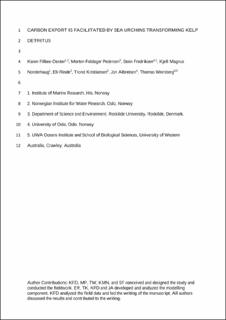| dc.contributor.author | Filbee-Dexter, Karen | |
| dc.contributor.author | Pedersen, Morten Foldager | |
| dc.contributor.author | Fredriksen, Stein | |
| dc.contributor.author | Norderhaug, Kjell Magnus | |
| dc.contributor.author | Rinde, Eli | |
| dc.contributor.author | Kristiansen, Trond | |
| dc.contributor.author | Albretsen, Jon | |
| dc.contributor.author | Wernberg, Thomas | |
| dc.date.accessioned | 2020-10-28T11:05:03Z | |
| dc.date.available | 2020-10-28T11:05:03Z | |
| dc.date.created | 2020-02-12T15:34:36Z | |
| dc.date.issued | 2019 | |
| dc.identifier.citation | Oecologia. 2019, 192 213-225. | |
| dc.identifier.issn | 0029-8549 | |
| dc.identifier.uri | https://hdl.handle.net/11250/2685473 | |
| dc.description.abstract | With the increasing imperative for societies to act to curb climate change by increasing carbon stores and sinks, it has become critical to understand how organic carbon is produced, released, transformed, transported, and sequestered within and across ecosystems. In freshwater and open-ocean systems, shredders play a significant and well-known role in transforming and mobilizing carbon, but their role in the carbon cycle of coastal ecosystems is largely unknown. Marine plants such as kelps produce vast amounts of detritus, which can be captured and consumed by shedders as it traverses the seafloor. We measured capture and consumption rates of kelp detritus by sea urchins across four sampling periods and over a range of kelp detritus production rates and sea urchin densities, in northern Norway. When sea urchin densities exceeded 4 m−2, the sea urchins captured and consumed a high percentage (ca. 80%) of kelp detritus on shallow reefs. We calculated that between 1.3 and 10.8 kg of kelp m−2 are shredded annually from these reefs. We used a hydrodynamic dispersal model to show that transformation of kelp blades to sea urchin feces increased its export distance fourfold. Our findings show that sea urchins can accelerate and extend the export of carbon to neighboring areas. This collector–shredder pathway could represent a significant flow of small particulate carbon from kelp forests to deep-sea areas, where it can subsidize benthic communities or contribute to the global carbon sink. | |
| dc.language.iso | eng | |
| dc.title | Carbon export is facilitated by sea urchins transforming kelp detritus | |
| dc.type | Peer reviewed | |
| dc.type | Journal article | |
| dc.description.version | acceptedVersion | |
| dc.source.pagenumber | 213-225 | |
| dc.source.volume | 192 | |
| dc.source.journal | Oecologia | |
| dc.identifier.doi | 10.1007/s00442-019-04571-1 | |
| dc.identifier.cristin | 1793608 | |
| dc.relation.project | Norges forskningsråd: 160016 | |
| dc.relation.project | Norsk institutt for vannforskning: 180144.211 | |
| dc.relation.project | Norges forskningsråd: 255085 | |
| cristin.ispublished | true | |
| cristin.fulltext | postprint | |
| cristin.qualitycode | 1 | |
